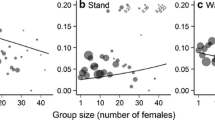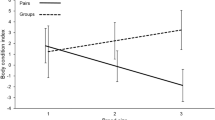Abstract
In facultatively eusocial hover wasps, some females leave their natal nests while others choose to stay and become helpers. We tested whether the decisions of 126 newly emerged females to stay or leave depended on group size: the number of females already resident on their natal nests. We predicted that females would be less likely to stay in larger groups, where the benefits of helping are probably smaller and there is a smaller chance of inheriting the dominant position. We also predicted that unrelated females would be less likely to join larger groups. We manipulated group size by removing residents from nests. Newly emerged females disappeared from their natal nests at a rate of 2.5% per day, but did not disappear from manipulated nests at higher rates than controls. Experimentally reducing group size also did not increase the frequency of joiners. Newly emerged females disappeared at twice the rate of older subordinate females, suggesting the existence of a `leaving window' early in life. One problem is the difficulty of distinguishing between leaving and death.
Similar content being viewed by others
Author information
Authors and Affiliations
Additional information
Received: 7 July 1998 / Accepted after revision: 25 October 1998
Rights and permissions
About this article
Cite this article
Field, J., Shreeves, G. & Sumner, S. Group size, queuing and helping decisions in facultatively eusocial hover wasps. Behav Ecol Sociobiol 45, 378–385 (1999). https://doi.org/10.1007/s002650050574
Issue Date:
DOI: https://doi.org/10.1007/s002650050574




